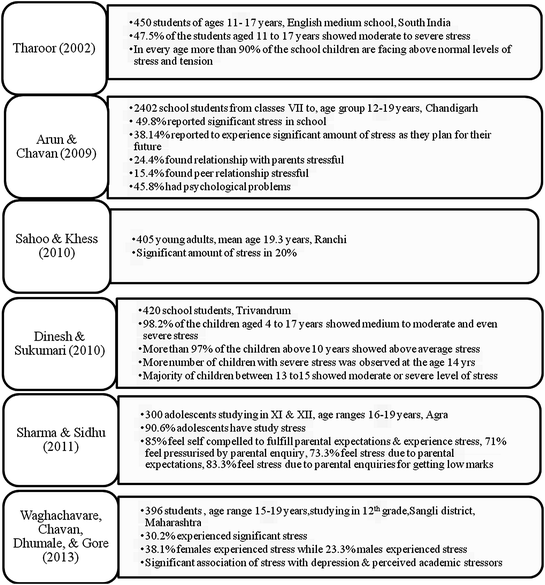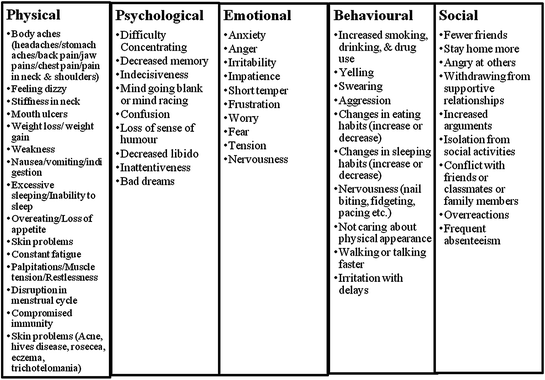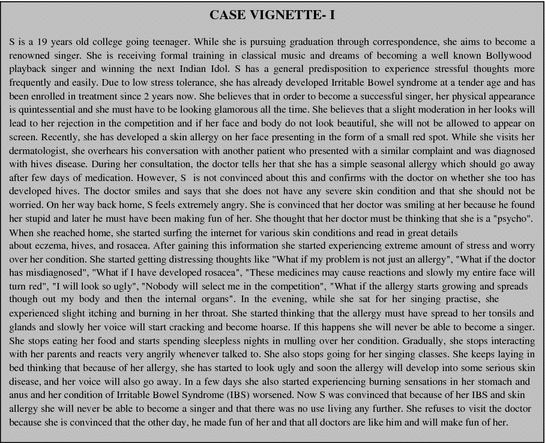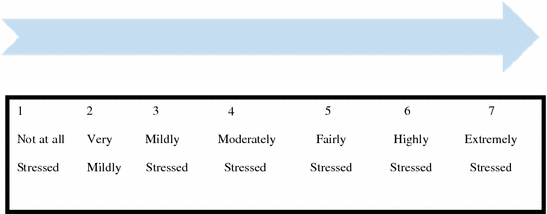Fig. 8.1
Eustress and distress
8.2 Prevalence of Distress Among Indian Adolescents
Stress is a condition of major public health concern, because of its high rate of prevalence and the high degree of dysfunction and suffering associated with it. Studies on stress in India are mostly based on the objective measures of stress and various causes of stress. Prevalence studies of stress in India have mostly been carried out in conjunction with prevalence of anxiety and depression. Daily hassles, academic pressure and career-related demands are the major causes of stress among Indian adolescents. According to Mehta (2000), majority of Indian adolescents experience mild to moderate levels of stress. Daily hassles are a significant cause of their stress. For many adolescents, examinations are a significant cause of emotional trauma and anxiety. Being labelled as “average” or “below average” may be extremely distressing and can lead to low self-esteem and poor academic concept. Even high achievers have high fears of failure and experience stress.
Figure 8.2 presents the prevalence rates of stress in adolescents in India.


Fig. 8.2
Prevalence of stress among Indian adolescents
Findings from other studies suggest that students in Government schools experience higher levels of stress than those in private schools. Students engage in higher use of avoidance coping (Augustine et al. 2011). Depression, anxiety and stress are higher among students in “board classes” (Bhasin et al. 2010). Findings from these studies reveal that managing stress among adolescents in India is the need of the hour.
8.3 Causes of Stress in Adolescents
Certain stressful situations are more likely to occur during particular developmental periods. Adolescent stress is an important, yet often overlooked, health issue. During this period, adolescents undergo a time of rapid body growth. It is also during this phase that they have to make crucial academic and professional decisions. Adolescence is also a period associated with identity development. The main causes of stress arising during adolescence have been highlighted in Table 8.1.
Table 8.1
Causes of stress in adolescents
Common sources of stress in adolescence | |
|---|---|
Academic stress | Pressure to perform well in school examinations, competitive college entrance examinations, apprehensions about not getting selected in a college of choice, examination anxiety, amount of time spent in school and tutorial classes |
Conflicts with parents | Parental aspirations and pressures related to career choices, incompatibility between adolescent’s demands for higher independence and parents continued thinking about them as children, higher reliance on peers, family beliefs about friendship and dating, arguments over substance use and automobile driving |
Peer-related demands | Peer group expectations, social status, change in relationships with friends, dating and break of relationships, stress arising from close friendships and romantic relationships, peer victimization, Lack of assertiveness, bullying, pressure to experiment with drugs and alcohol |
Body image issues | Poor body image, perception of being obese, pressure to have a particular body size or shape (Girls focussing on body weight, boys focussing on having muscular or athletic physique), concern related to physical appearance (having acne or other skin-related problems as a sign of being ugly), pressure to wear certain types of clothes, follow certain types of fashion trends |
Mood disruptions related to adolescence | Rapid mood fluctuations naturally occurring during this stage, feeling easily self-conscious, embarrassed, awkward, lonely or ignored, poorer emotional understanding, difficulty managing negative emotions, poor confidence over ability to manage emotions, poor self-control, poor control over impulses |
8.4 How Does Body React to Stress
According to Selye (1978), the state of stress can be recognized only by its physiological manifestations. He defined stress as “an adaptive or defensive reaction to an event or stimulus” and labelled it as the General Adaptation Syndrome (G.A.S.), which occurs in three stages: the alarm reaction (A.R.), the alarm resistance (A.R.) and the stage of exhaustion (S.E.).
The alarm reaction is a physiological response made by the body for alerting the defensive forces within the individual. In this stage, blood is diverted towards the skeletal muscles in order to prepare them for action in response to a stressor.
If the stress exposure remains, the stage of resistance follows. In this stage, the body begins to restore balance, recover depleted body sources, and start renewal and repair. If the stressor still persists, the body starts adapting itself with continued effort in resistance. During this phase, the body continues to remain in a state of arousal. If an individual accepts that the stressor is a necessary part of life, it may persist indefinitely. In such a condition, the person becomes highly vulnerable to a wide range of stress-related problems and diseases.
With long-term stress exposure, the individual enters the third stage, the stage of exhaustion. During this stage, the risk of emotional and physical problems increases and the individual starts experiencing symptoms such as loss of morale and feelings of loss of control and may finally collapse.
8.5 Signs of Stress Among Adolescents
The impact of maladaptive responses to stress can manifest in five main domains—physical, psychological, emotional, behavioural and social. The most common signs of stress seen in adolescents are highlighted in Fig. 8.3.


Fig. 8.3
Common signs of stress among adolescents
Adolescents may also experience certain types of thoughts that can precipitate, lead to, maintain or heighten the experience of stress. These thoughts generally represent certain dysfunctional styles in thinking and cognitive distortions. A list of cognitive distortions is provided in the Appendix.
Common examples of the thoughts experienced by adolescents during stress are included in Fig. 8.4.


Fig. 8.4
Examples of common stress-related cognitions
While these thoughts can lead to experience of stress, they can also be seen as by-products of stress. The experience of these thoughts can prolong the effects of stress among adolescents. Cognitive behaviour therapy (explained in detail in subsequent sections) can serve as a promising treatment modality in dealing with these cognitions.
8.6 Implications of Untreated Stress
Stress can have numerous detrimental effects on adolescents. Stress generally elevates the production of cortisol, a stress hormone, which not only impairs memory but also general health. Between 50 and 80 % of all diseases, at least in part, have stress-related origins (Humphrey 2004). There is a strong correlation between an increase in stressful events and a decrease in health and psychological functioning (Newcomb et al. 1981). In the longer term, stress can have a very cumulative and wide-ranged effects on health (Table 8.2).
Table 8.2
Effects of chronic stress
Effects of chronic stress | |
|---|---|
Physical | Psychiatric |
Increased blood pressure | Depression |
Compromised immunity | Anxiety |
Frequent cold and flu | Dissociation |
Hormonal imbalance | Psychogenic vomiting |
Indigestion/lack of appetite/ulcers | Forgetfulness |
Irritable bowel syndrome | Somatisation |
Crohn’s disease | Panic attacks |
Frequent exacerbation of asthma | Generalized anxiety |
Acne | disorders |
Eczema | Alcohol dependence |
Hives | Nicotine dependence |
Rosacea | Drug abuse |
Psoriasis | |
Vitiligo (de-pigmented white spots on skin) | |
8.7 Coping with Stress and Building Resilience
Effectively managing stress mainly involves taking charge over one’s thoughts and feelings and finding a way to deal with the problems. Adolescents can learn to become more resilient by changing how they think about their problems and life situations. Resilience can be defined as the ability to cope well with challenging situations and a context of positive adaptation in light of adversity. Resilient individuals generally use more effective coping strategies, have a realistic understanding of situations and have better tolerance and control over their feelings.
Thus, building resilience essentially involves learning to develop good coping skills. Two main types of coping styles have been widely reviewed—problem-focussed coping (approach oriented) and emotion-focussed coping (avoidance oriented).
Problem-focused coping (approach-oriented coping) aims at changing the source of the stress. For example, if a student is stressed about an upcoming exam, the problem-focused approach for the student would be to devote more time for studying. The student may also ask friends and teachers for help. Emotion-focussed coping (avoidance oriented) aims towards reducing or managing the emotional distress related to a situation. Examples include denial, avoidance, and procrastinating. Studies suggest that females generally use more emotion-focused coping strategies while males tend to use more problem-focussed strategies. Adolescents often use less effective coping strategies such as wishful thinking, self-blame, complaining, making excuses, not communicating, bullying, becoming withdrawn, smoking or drinking. While these coping strategies may temporarily reduce stress, they are counterproductive and may worsen the stress and cause more damage in the long term. Adolescents can learn healthier ways to manage stress by learning more effective and problem-focussed coping strategies. These may include developing problem-solving skills, developing positive thinking, developing more flexible styles of thinking, maintaining an optimistic outlook, learning better time management, developing a balance between work and leisure, engaging in regular physical exercise, practising relaxation exercises, spending time with friends, sharing problems with a friend or family member, expressing feelings instead of bottling them up, developing more effective communication skills, maintaining healthy eating and sleeping habits, maintaining a stress diary, indulging in a hobby, reading a novel or comics, watching a funny movie or videos, listening to music, doing something creative such as drawing or painting and playing with pets. These coping strategies are more problem focussed and help in building resilience to stress.
8.8 Need for Management of Stress Among Adolescents
Stress is related to a wide range of health-related problems among adolescents. Chronic stress can cause hormonal imbalance and has emerged as a key risk factor in development of many physical and psychiatric illnesses and lifestyle-related diseases as seen in the previous section. Academic stress among adolescents is emerging as a leading problem which requires immediate concern. “Today stress levels among children and adolescents have been going up dangerously due to the pressure of their academic or cultural activities. Not all children can cope with such high levels of expectations and parents do not seem to realize or accept that their children are under severe pressure” says Elizabeth Vadakkekkara, a child psychologist and director of Thrani; a counselling centre in Kerala focussing on crisis intervention and suicide prevention (The Hindu 2003). Many adolescents believe that nothing can be done to avoid stress. Poor coping strategies used by adolescents can have significant short- and long-term consequences on their physical and emotional health. Stress management has thus become a need of the hour for adolescents in India. Teaching several coping strategies such as seeking social support, cognitive restructuring, positive self-talk, problem solving, relaxation, physical activity, sleep and diet regulation, cognitive restructuring and self-talk can serve to be successful in combating stress among adolescents and promising a healthy lifestyle.
8.9 Case Vignette
The case illustration provided in Fig. 8.5 highlights the case of a 19-year-old female with significant body image issues and cognitive distortions experiencing significant amount of stress and developing a stress-related condition (Irritable Bowel syndrome).


Fig. 8.5
Case illustration
8.10 Assessment of Stress
Assessment of stress involves identification of signs of stress, the causes (stressor), and the present demands and resources of the individual. This can be carried out using detailed interviews, providing the adolescents with self-assessment records, and through structured questionnaires and inventories.
8.10.1 Interview-Based Assessment
The experience of stress, level of stress, signs and symptoms, and nature of coping can be assessed using open-ended questions. Various questions that can be asked to assess for presence of stress and its related symptoms are provided in Table 8.3.
Table 8.3
Interview-based assessment of stress
List of questions used for eliciting stress |
|---|
How do you know when you are feeling stressed? |
What are the first things you notice when you experience stress? |
What are your early warning signs of stress? |
Where do you feel stress in your body? |
What do you notice about your body, thoughts and feelings when things are difficult? |
How do you behave when you are feeling stressed out? |
Do you often feel weepy or irritable? |
Do you feel things are getting on top of you? |
How do you react to stress? |
How do you currently cope with stress? |
How do you usually handle stress? List your usual coping habits. |
How effective are the coping behaviours you have used in the past? Do they reduce or eliminate the stress? |
8.10.2 Self-monitoring
Adolescents can also be provided with daily logs to monitor stress. They may be asked to maintain a regular record of situations in which they feel stressed and the thoughts, feelings, and sensations they experience in order to monitor for signs of stress. Thus, in the case vignette given in Fig. 8.5, S can be asked to keep the record provided in Table 8.4.
Table 8.4
Daily logs for recording stressful situations and responses to stress
Situation | Automatic thoughts | Emotions | Physical sensations |
|---|---|---|---|
Saw the red spot on face deepen in colour | This is not a simple allergy. The doctor has misdiagnosed me. This is a sign for some serious skin disease. There is something terribly wrong with my looks. How will I go out? How will I face my friends? They will make fun of me | Anxious, tensed | Palpitations, heaviness in head |
Stress journals can be provided for monitoring the stressors and the usual coping responses. In the same example in the case vignette, S could be asked to maintain the journal as provided in Table 8.5.
Table 8.5
Stress journal
Time | Stressor | Feelings | How you coped | Effect of coping |
|---|---|---|---|---|
∙ Effective | ||||
∙ Partly effective | ||||
∙ Not at all effective | ||||
Wednesday 2:30 pm | Missed my music class | Irritation, anger | Locked my room from inside and kept laying in bed thinking about how terrible my day was because I couldn’t go for the music class | Not at all effective, felt worse about the whole thing |
Self-monitoring sheets to assess the level of stress among adolescents can also be provided. Adolescents can be asked to maintain a record that indicates their daily level of stress. Ratings may be done as provided in Table 8.6.
Table 8.6
Daily stress monitoring log
 | |||||||
Sunday | Monday | Tuesday | Wednesday | Thursday | Friday | Saturday | |
Time 1 (10 am) | Rating | ||||||
2 | |||||||
Time 2 (12.30 pm) | 5 | ||||||
Time 3 (6.48 pm) | 7 | ||||||
Time 4 (10.32 pm) | 4 | ||||||
Day overall | 5 | ||||||
8.10.3 Questionnaires and Inventories
Several self-report measures for assessment of stress among adolescents are also available. These are given in Table 8.7.
Table 8.7
List of tools for assessment of stress
Name of the tool | Description |
|---|---|
Acute stress checklist for children (ASC-Kids), Kassam-Adams (2006) | ASC-Kids is a 29-item self-report measure used to assess acute stress reactions within the first month after exposure to a potentially traumatic event. The questionnaire can be administered within the age group of 8–17 years |
Adolescent coping orientation for problem experiences (A-COPE); Patterson and Mc Cubbin (1987) | The A-COPE is a 54-item scale designed to explore the coping behaviours among adolescents that are associated with normal stress. The scale identifies 12 different coping patterns: ventilating feelings, seeking diversions, developing self-reliance and optimism, developing social support, solving family problems, avoiding problems, seeking spiritual support, investing in close friends, seeking professional support, engaging in demanding activity, being humorous and relaxing |
Stressful life events scale (LES) (Aggarwal et al. 2007) | LES has been developed exclusively for Indian adolescents and is a culturally adapted version of social readjustment rating scale. It is a 40-item scale where the adolescents are asked to report only the events which had occurred in their lives in the past one year. The scores are interpreted as composite weighted scores and second-order groupings of controllable, uncontrollable and distressful events
Stay updated, free articles. Join our Telegram channel
Full access? Get Clinical Tree
 Get Clinical Tree app for offline access
Get Clinical Tree app for offline access

|



